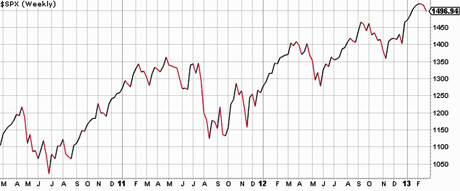Investing can sometimes be a painful process. We see the positive long term numbers and wish that the trend line was a nice, steady, upward slope. But that’s not the way investing works — never has been. A 12% annual return rarely means a 1% rise every month for 12 months. It simply doesn’t work that way.
Why? What does history teach us about stock market growth? What should we expect?
Lessons from history
The idea of an upward trend really is correct, because history shows that’s generally what happens in time. At the same time, that uptrend is usually dotted with declines, sometimes big ones, that have no pattern and that can’t be predicted.
Look at what happened to the S&P 500 over the past three years …
S&P 500 Index Weekly Close
Feb 27, 2010 – Feb 26, 2013

The overall trend has been up. But it wasn’t slow and steady, was it?
Now consider the past 33 years …
In the last 33 years, the S&P 500 Index has dropped at least 10% during a calendar year 19 times. The average intra-year decline in those 33 years was nearly 15%.
On the face of it, those statistics can be kind of scary. But looked at another way, they can help you get through the next market drop, the next political crisis, or the next frightening news headline.
History tells us that if we invest in equities, sometime during a calendar year we’re likely to see a drop of 10% in our accounts. This occurs about 6 times every 10 years. So, it’s the years when we don’t see fluctuations like that that are not normal, not the years when we do. (Source: J.P.Morgan, “Guide to the Markets.” Dec. 31, 2012, p. 63.)
When stocks drop, don’t scramble
So market fluctuation is perfectly normal. Some ups and downs are to be expected. It doesn’t mean that we have to scramble around and Do Something.
Neither does it mean we should ignore it, but if we know that we’re going to go through times where things aren’t going well, it’s easier to make objective, well-thought-out decisions.
Historically, market declines have been temporary. It often doesn’t feel like that at the time. But there are steps and strategies that you can take to help manage your portfolio’s volatility and your overall expectations for performance. For example, CD’s are a great alternative to investments that can decline in value. While CDs may limit your upside potential, adding them to your investment plan can help you sleep better at nights — if market gyrations are causing you to lose some sleep.
Remember, reacting to the markets rarely pays off. The average investor realizes personal gains far less by operating on their own whims, than do those investors who simply stick with the markets long-term and reap gains in due course. The reason? Investors tend to make the wrong decisions on stock investing at the wrong time. (Source: Symmetry Partners, “Understanding Why,” Feb. 1, 2012, p. 2)
Why not stop in or give me a call so that we can continue this conversation in person. I truly believe that knowledge about the true nature of the market’s dynamics can help give you more realistic expectations. This in turn can lead to your making better decisions.

